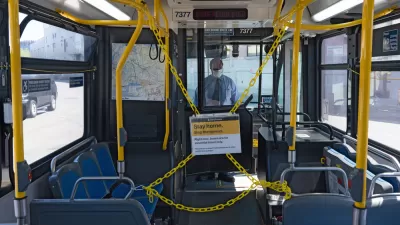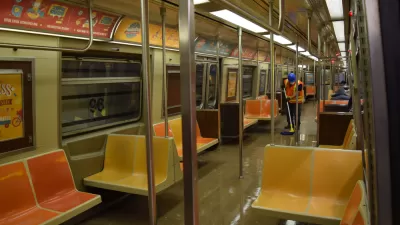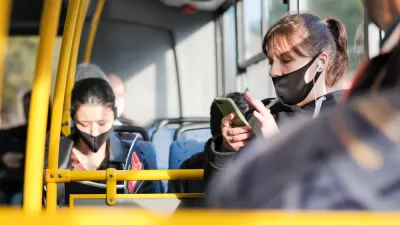The effects of a global pandemic on American shores are beginning to emerge for public transit systems. The consequences of a drop in transit ridership could extend beyond the end of the pandemic.

On March 9, Toronto Public Health officials released an announcement assuring residents that was safe to use public transit amidst the coronavirus scare, reports Ben Spurr. The announcement responded to a far less assuring announcement, made the day before by Governor Andre Cuomo and Mayor Bill De Blasio, suggesting residents of New York City should avoid public transit to help prevent the spread of the coronavirus.
COVID-19 hit close to home for the New York Port Authority—Rick Cotton, the executive director of the Port Authority of New York and New Jersey, is one of the confirmed cases in the pandemic.
Last week, expectations about how coronavirus would impact public transit relied on experience from Asian countries, but following the announcement about Cotton and the statements of New York's political leadership, U.S. transit systems began to feel the effects. Transit ridership dropped by 170,000 passengers—8 percent—on BART between the last week of February and the first week of March, according to an article by Rachel Swan. [Update: Reports now reveal ridership on the New York MTA system dropped 18.5% on Wednesday, March 11 relative to the comparable day in 2019—a total of 996,000 riders.]
As pointed out in an article by Aaron Gordon, decreased transit ridership could have a long-term impact of transit funding, and not just because of a reduced amount of fares being paid by riders as they work from home and avoid public gatherings that tend to drive transit ridership (as driving is additionally incentivized by plummeting oil prices).
On average, 56 percent of a transit agency’s budget comes from state or local subsidies, according to that same Department of Transportation report—the rest comes from the federal government or is directly generated by the agency through advertising or other initiatives—and a big part of convincing politicians those subsidies are worthwhile is by demonstrating people use the system with, you guessed it, ridership figures.
So, if ridership plummets, that argument becomes harder, especially if government budgets become stressed bailing out all the other at-risk businesses and populations that need more money. When it comes to governments at all levels, transit has a long history of taking the back seat during crunch time. And if people abandon it in droves due to coronavirus, history may repeat itself once again.
FULL STORY: Coronavirus May Have a Lasting Impact on Public Transit Funding

Alabama: Trump Terminates Settlements for Black Communities Harmed By Raw Sewage
Trump deemed the landmark civil rights agreement “illegal DEI and environmental justice policy.”

Planetizen Federal Action Tracker
A weekly monitor of how Trump’s orders and actions are impacting planners and planning in America.

The 120 Year Old Tiny Home Villages That Sheltered San Francisco’s Earthquake Refugees
More than a century ago, San Francisco mobilized to house thousands of residents displaced by the 1906 earthquake. Could their strategy offer a model for the present?

In Both Crashes and Crime, Public Transportation is Far Safer than Driving
Contrary to popular assumptions, public transportation has far lower crash and crime rates than automobile travel. For safer communities, improve and encourage transit travel.

Report: Zoning Reforms Should Complement Nashville’s Ambitious Transit Plan
Without reform, restrictive zoning codes will limit the impact of the city’s planned transit expansion and could exclude some of the residents who depend on transit the most.

Judge Orders Release of Frozen IRA, IIJA Funding
The decision is a victory for environmental groups who charged that freezing funds for critical infrastructure and disaster response programs caused “real and irreparable harm” to communities.
Urban Design for Planners 1: Software Tools
This six-course series explores essential urban design concepts using open source software and equips planners with the tools they need to participate fully in the urban design process.
Planning for Universal Design
Learn the tools for implementing Universal Design in planning regulations.
Clanton & Associates, Inc.
Jessamine County Fiscal Court
Institute for Housing and Urban Development Studies (IHS)
City of Grandview
Harvard GSD Executive Education
Toledo-Lucas County Plan Commissions
Salt Lake City
NYU Wagner Graduate School of Public Service





























